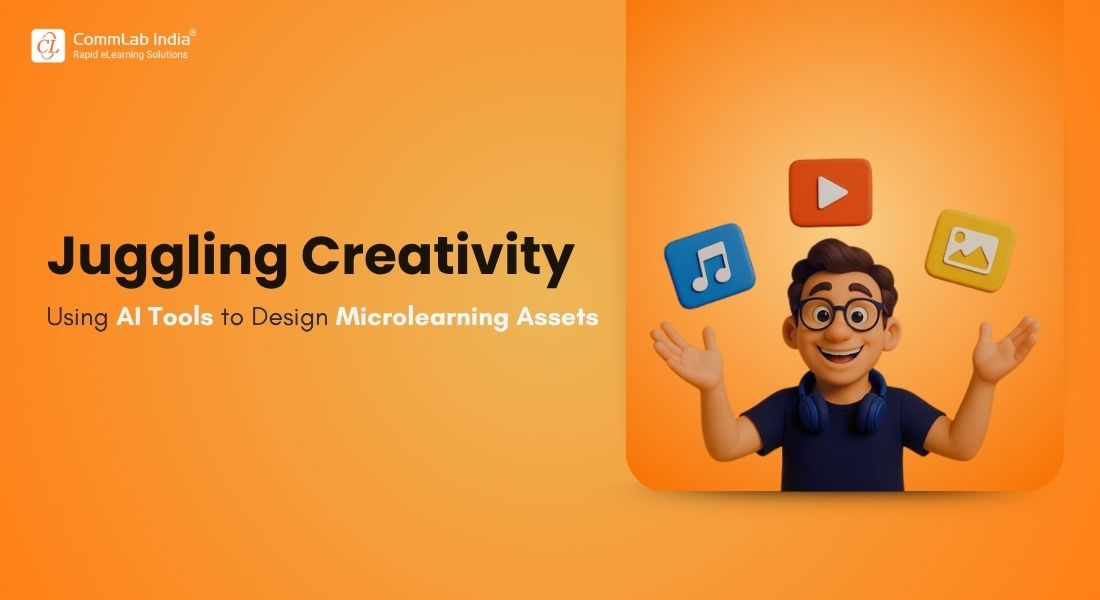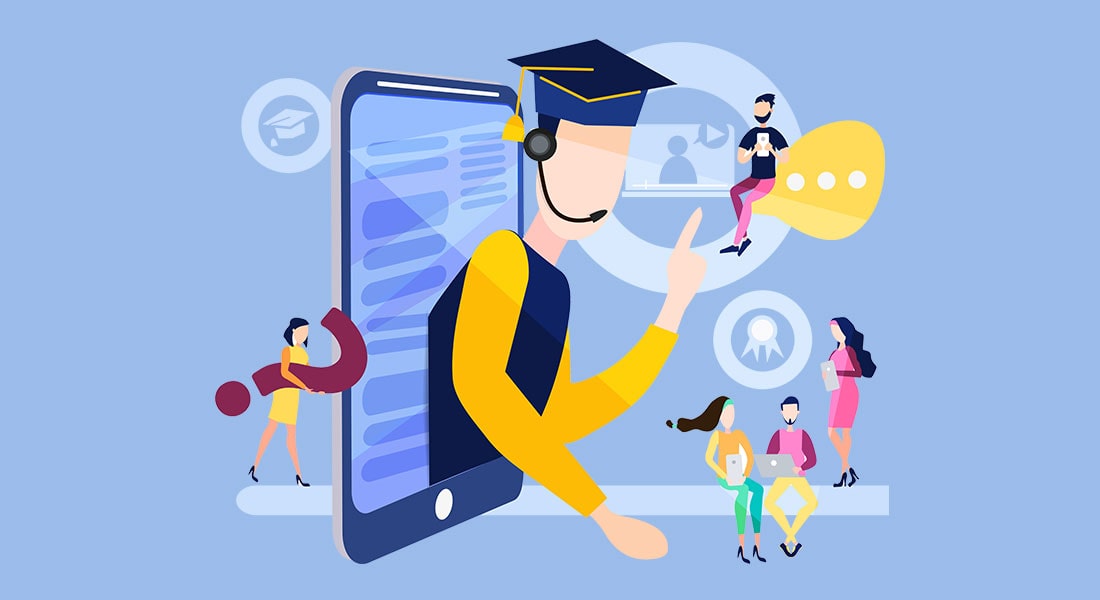How Corporate Training Companies Are Evolving with Gamification, Microlearning, and AI

In today’s fast-paced, hybrid work environment, traditional training methods are no longer sufficient. Employees are distracted, distributed, and demanding more personalized, engaging learning experiences.
Enter: Gamification, Microlearning, and AI—the three game-changers transforming corporate learning. And who’s leading the charge?
Top corporate training companies!
These providers are setting new standards by adopting these innovations to help global organizations upskill faster, boost engagement, and drive measurable results. The world’s best corporate training partners aren’t just delivering content. They’re creating learning experiences—ones that are immersive, data-driven, and learner-centric.
→ Download eBook: Corporate L&D Trends 2025 – Get the View from the Trenches
Table Of Content
- How Top Corporate Training Companies Are Leveraging Gamification, Microlearning, and AI
- Why the Power Trio Works—and How the Best Corporate Training Companies Are Using It
- Evolve or Fall Behind: Why the Right Training Partner Matters
How Top Corporate Training Companies Are Leveraging Gamification, Microlearning, and AI
Leading corporate training providers are setting new benchmarks by combining gamification, microlearning, and artificial intelligence (AI) to deliver cutting-edge learning solutions. This powerful trio is helping organizations scale learning, boost engagement, and drive measurable results—addressing the modern learner’s need for speed, personalization, and motivation.
1. Gamification
Top training companies embed gamification elements like points, badges, leaderboards, and scenario-based challenges into their digital learning solutions. This makes learning fun and competitive, boosting motivation and retention. According to the TalentLMS, 2022 Gamification Survey Report, Gamification increases learner engagement by up to 60% and improves knowledge retention by up to 40%. Leading corporate training providers are using game mechanics in compliance training, onboarding, and sales enablement to drive consistent participation and measurable improvements in performance.
2. Microlearning
Industry leaders design content in bite-sized formats—short videos, flashcards, infographics, and quizzes—ideal for today’s mobile-first, time-strapped workforce. According to the Journal of Applied Psychology, Microlearning makes learning 17% more efficient and boosts knowledge transfer by up to 50% compared to traditional methods. Top companies use microlearning for just-in-time training and performance support—especially effective for frontline, remote, and distributed teams.
3. Artificial Intelligence (AI)
AI is the backbone of personalized and data-driven learning. Leading training companies are integrating AI to tailor learning paths, recommend relevant content, and provide on-demand support through chatbots or intelligent tutors. As per the LinkedIn Workplace Learning Report, 49% of L&D professionals say AI will significantly improve personalization in learning within the next two years. AI also equips L&D leaders with predictive analytics to forecast learning needs, close skill gaps, and improve training ROI.
By combining these strategies, top corporate training companies are delivering high-impact, learner-centric training experiences that are not only engaging but also drive performance, retention, and ROI. This integrated approach is reshaping the future of workplace learning— making it smarter, faster, and more effective.
Why the Power Trio Works—and How the Best Corporate Training Companies Are Using It:
How Top Corporate Training Companies Are Leveraging the Power Trio
Discover how three innovative strategies are transforming corporate training:
- Gamification
- Microlearning
- Artificial Intelligence
The combination of gamification, microlearning, and AI isn’t just a passing trend—it’s a strategic shift in how learning is designed and delivered. When used together, these approaches reinforce each other to create training that’s engaging, personalized, and performance-driven. Top corporate training companies are not only adopting these methods—they're integrating them seamlessly into their learning ecosystems to meet the evolving expectations of modern learners.
Here’s how each component contributes to this transformation—and how the best in the business are putting them to work:
1. Gamification in Corporate Training: Turning Learning into an Experience
Did you know that 83% of employees feel more motivated when training includes gamified elements, according to the TalentLMS Gamification Survey, 2023 ? In fact, organizations that incorporate gamification into their learning strategies report up to a 60% increase in learner engagement, as noted by Zippia, 2023. Supporting this trend further, a report from GamificationHub.org highlights that 89% of employees believe gamification makes them feel more productive at work. These insights underscore the growing importance of gamification in corporate training for boosting motivation, engagement, and overall productivity.
Today’s workforce doesn’t just expect training—they expect an experience. Static PDFs and monotone lectures no longer cut it. That’s where gamification comes in —a strategy that’s revolutionizing corporate training. By weaving in game mechanics such as points, badges, levels, leaderboards, story-based challenges, and immediate feedback, top corporate training companies are elevating dull compliance modules and SOP refreshers into dynamic, high-impact learning environments. When deployed effectively, gamification creates purpose-driven learning that aligns both with business goals and human motivation.
Why It Works
Gamification taps into core psychological drivers—achievement, autonomy, mastery, competition, and purpose>—to boost learner engagement and participation.
According to GamificationHub.org, these mechanics turn passive learners into active participants, increasing not only completion rates but also voluntary re-engagement with learning platforms. Whether it’s sales enablement, customer service, or technical upskilling, gamified content ensures learners:
- Return frequently
- Progress consistently
- Retain more effectively
Gamified training boosts the release of dopamine, a neurotransmitter tied to motivation, memory, and attention. Every badge earned or leaderboard climbed reinforces learning and builds emotional investment, making content stick long after the training ends.
Plus, platforms that enable instant feedback loops—similar to what users expect from mobile games—build positive reinforcement pathways, turning training into a habit rather than a one-time event.
Learn how gamification can transform employee training into an engaging and effective experience in this video!
Real-World Scenario: Retail Giant Revamps Compliance Training
A global retail chain faced a challenge familiar to many CLOs: compliance training was tedious, poorly retained, and often ignored.
To re-engage their frontline workforce, they partnered with a top corporate training company specializing in gamification. Their approach included:
- Mission-based learning paths that simulated real-world decision-making
- Leaderboards to create healthy peer competition
- Achievement badges for milestones like first completion or highest quiz score
- Story-driven scenarios that mirrored actual workplace compliance issues
Within just 90 days of implementing gamified training, the organization experienced remarkable results: a 50% increase in course completion rates, a 40% improvement in knowledge retention, and a 30% rise in learner satisfaction. These outcomes highlight the powerful impact gamification can have on both learner engagement and training effectiveness. Employees called the new format “fun, challenging, and relevant.” Managers reported fewer compliance errors and faster onboarding for new hires.
L&D Leader Takeaway

Gamification is not about turning work into play—it’s about turning training into an experience. For forward-thinking Learning and Development professionals, it’s a must-have in your instructional design strategy.
Beyond just boosting engagement, gamification also plays a crucial role in driving behavior change, enabling performance tracking, and promoting on-the-job application of skills. When combined with platforms that leverage AI and analytics, gamification provides deeper insights into learner behavior, content effectiveness, and overall business ROI—making it a powerful tool for any results-driven L&D strategy.
Gamification is redefining corporate learning. With the right strategy and vendor, it becomes a powerful tool to boost motivation, drive performance, and build a learning culture that lasts.
2. Microlearning: Training in Bite-Sized, Impactful Segments
Microlearning solutions delivers content in short, focused modules, typically 3–7 minutes long. These bite-sized lessons are designed to meet a single learning objective and are often presented in formats like videos, infographics, interactive scenarios, or flashcards. Unlike traditional training formats, microlearning fits seamlessly into an employee’s workflow, enabling them to learn on the go, exactly when they need it.
Why Microlearning Works
Research proves that microlearning increases retention by up to 80%—especially when delivered using spaced repetition techniques. Microlearning offers several key benefits that make it a powerful tool for modern corporate training. One of the most significant advantages is its ability to boost knowledge retention by up to 80%, particularly when paired with spaced repetition. It's also mobile-friendly and accessible anytime, anywhere, allowing learners to engage with content on their own schedule and at their own pace. Additionally, microlearning reduces training time by as much as 50% without compromising effectiveness (Training Industry Report), making it an efficient solution for organizations. Also, it’s ideally suited for adult learners who often face shorter attention spans and heavy workloads, ensuring that training fits seamlessly into their day-to-day responsibilities.

Real-World Case Study
A global tech firm partnered with a leading corporate training provider to overhaul its onboarding process. Instead of the traditional two weeks of classroom training, the company implemented a series of targeted microlearning modules. This shift resulted in a 40% faster time-to-productivity and a 50% reduction in overall training hours. New hires reported higher engagement and satisfaction, noting that the bite-sized content made learning more digestible and easier to retain.
This transformation aligns with a broader industry trend. According to a recent MarketsandMarkets report, the microlearning market is projected to grow from USD 2.7 billion in 2023 to USD 5.5 billion by 2028, driven by the demand for flexible, mobile-friendly training solutions. The report emphasizes how microlearning meets the needs of modern learners—particularly in fast-paced industries—by supporting just-in-time learning, improved retention, and higher learner engagement.
For organizations aiming to streamline training and boost performance, microlearning isn’t just a tactical shift—it’s a strategic investment.
What Makes an Effective Microlearning Program?
A well-executed microlearning strategy does more than just deliver short content—it transforms the learning experience into something timely, relevant, and results-driven. If you're an L&D leader looking to implement or enhance microlearning, here’s what to include for maximum impact:
- Mobile-First Design: Today’s learners are always on the move. Designing content for smartphones and tablets ensures accessibility anytime, anywhere—whether employees are on the shop floor, in transit, or between meetings. Mobile-first microlearning supports learning in the flow of work and encourages consistent engagement.
- Short Videos and Animations: Microlearning thrives on brevity. Use 3–5 minute videos or animated explainers to break down complex topics into digestible chunks. Visual content helps reinforce memory retention and is especially effective for learners who prefer visual and auditory cues.
Discover how microlearning videos can transform eLearning by delivering quick, engaging, and impactful lessons that fit into any schedule!
- Interactive Knowledge Checks: Passive learning doesn’t stick. Embedding quizzes, drag-and-drop exercises, or scenario-based questions after each module keeps learners involved and encourages active recall—a proven method for long-term retention.
- Real-World Scenarios: Grounding your training in practical, job-relevant scenarios bridges the gap between theory and application. Learners absorb faster when they can connect content to their daily tasks. This is particularly effective in sales, customer service, and technical roles.
- Personalized Recommendations Using AI: Top corporate training companies are now integrating AI to personalize the learning journey. Based on a learner’s progress, role, or skill gaps, AI-driven platforms can recommend what to learn next—creating a tailored path that boosts both engagement and performance.
- Performance Analytics to Track ROI: A good microlearning platform isn’t just about delivery—it’s about insights. Analytics dashboards allow you to monitor completion rates, quiz scores, time spent, and behavioral impact. This data helps you refine your content and prove the ROI of your training efforts.
Microlearning isn’t just about shorter content—it’s about smarter delivery. By aligning microlearning design with learner behavior, technology, and measurable outcomes, you can drive real performance improvements across the board. If you’re evaluating top corporate training companies, look for partners who specialize in AI-driven personalization, scenario-based design, and robust analytics. These features will ensure your microlearning strategy is not only engaging but also business-aligned.

Corporate L&D Trends 2025
Get the View from the Trenches
- Win with AI
- Design for the agile workforce
- Unlock scale, volume, quality
- Make an impact
- Much more
3. AI in Corporate Training: Personalization at Scale
Artificial Intelligence (AI) is rapidly transforming corporate training, offering unprecedented opportunities for personalization, efficiency, and scalability. AI in corporate training involves using technologies such as machine learning, natural language processing, and predictive analytics to deliver tailored and dynamic learning experiences. These tools help create smart systems that evaluate individual learner requirements, modify content instantly, and offer valuable insights to enhance training effectiveness.
In today's dynamic work environment, traditional training methods often fall short in addressing the unique needs of each employee. AI addresses this gap by:
a. Creating Adaptive Learning Paths with AI: The Future of Personalized Training
In today’s fast-paced corporate environment, one-size-fits-all training approaches are quickly becoming outdated. Employees come with diverse learning styles, varying skill levels, and unique performance goals. That’s where adaptive learning paths, powered by AI, revolutionize how we approach corporate training.
Adaptive learning paths are personalized learning journeys that adjust in real time based on the learner’s behavior, performance, preferences, and pace. Rather than assigning uniform content to every employee, AI-driven systems analyze individual learning patterns and dynamically recommend the most relevant modules, formats, and assessments.
AI uses data points such as quiz scores, content completion rates, engagement levels, and even time spent on certain topics to map out what an individual learner already knows, where they struggle, and what they need to learn next. According to Edstellar, the AI engine continuously updates the learner’s path, ensuring they are always moving toward skill mastery efficiently and effectively.
Key Features of AI-Driven Adaptive Learning:
- Skill-Based Customization: AI matches training modules with the learner’s current role, performance metrics, and future goals.
- Real-Time Feedback & Adjustments: Based on learner interaction, AI immediately suggests alternate resources such as videos, simulations, or microlearning nuggets.
- Multi-Format Delivery: AI recommends formats best suited to the learner—be it visual (animations), auditory (podcasts), or kinesthetic (interactive simulations).
Personalized learning powered by AI si gnificantly accelerate upskilling by allowing learners to bypass content they’ve already mastered and focus on areas where improvement is needed. This targeted approach not only saves time but also improves knowledge retention, as learners stay engaged and avoid cognitive overload from unnecessary material. For L&D teams, the benefits go even further—AI provides data-driven insights into training effectiveness and individual learner progress, resulting in a higher return on investment (ROI) and more strategic decision-making in workforce development.
Adaptive learning powered by AI is not just a trend—it’s a necessity for modern workforce development. It aligns training with business needs, respects the learner’s time, and empowers employees with exactly what they need to grow. To stay competitive, L&D leaders must invest in AI-enabled platforms that can intelligently adapt learning to each employee, ensuring both organizational efficiency and learner satisfaction.
b. Real-Time Support: AI-Powered Assistance That Boosts Engagement and Understanding
One of the most powerful applications of AI in corporate training is real-time learner support—enabled through intelligent tutoring systems (ITS), virtual assistants, and AI-driven chatbots. This on-demand guidance offers learners a personalized, just-in-time learning experience, eliminating the frustration of waiting for human intervention.
What It Means
AI-powered support systems are revolutionizing learner assistance by acting as always-on, intelligent digital mentors. Unlike traditional static resources, these systems offer real-time, contextual help—tailored to individual learner needs. Whether it's clarifying complex concepts, recommending supplementary resources based on learning behavior, answering frequently asked questions, or guiding users through a module step-by-step, AI ensures that help is immediate and personalized.
These systems—such as intelligent tutoring systems and AI chatbots—leverage natural language processing (NLP) and machine learning to understand learner intent and provide accurate, human-like responses. This minimizes frustration and downtime during training, increasing learner satisfaction and comprehension.
For example, a learner stuck on a simulation or policy update can get instant clarification or even a video walkthrough recommended by the AI, instead of waiting for instructor support or combing through manuals. Over time, the AI learns from user interactions, becoming more accurate and predictive in its assistance.
This kind of just-in-time support not only boosts learner engagement but also helps L&D teams scale personalized learning across geographies and time zones—ensuring consistent and efficient support for every employee. These intelligent agents analyze learner behavior and context in real time to provide contextual and adaptive assistance—much like a personal coach who’s available 24/7.
Why It Matters and How it Works
According to Training Industry, real-time support plays a critical role in boosting learner confidence, reducing dropout rates, and promoting deeper understanding. It empowers learners to overcome hurdles independently, without derailing their momentum or motivation.
AI-powered learning support works through a combination of advanced technologies that adapt and respond to learner needs in real time. Natural Language Processing (NLP) allows AI chatbots to understand and respond to learner queries in a conversational, human-like manner, making interactions feel more intuitive and less mechanical. Behind the scenes, Machine Learning algorithms continuously improve these responses by analyzing past learner interactions, improving accuracy and relevance over time. Additionally, behavioral analytics play a crucial role by monitoring user activity to detect signs of confusion or disengagement—such as repeated errors or long pauses. When these indicators are identified, the system proactively intervenes with support elements like pop-up tips, brief video explainers, or interactive quizzes to re-engage the learner and reinforce understanding. This dynamic support model ensures learners receive timely, personalized help, keeping them on track and motivated throughout their training journey.
Real-time AI support bridges the gap between self-learning and instructor-led training. By making learners feel supported at every step, it enhances engagement, accelerates comprehension, and builds learner autonomy. For L&D teams striving to deliver high-impact learning at scale, real-time AI assistance is no longer optional—it’s a strategic must.
c. Delivering Predictive Analytics for Skill Gaps
One of the most transformative uses of Artificial Intelligence in corporate learning is its ability to identify, predict, and bridge skill gaps before they have any impact on business goals. By harnessing AI-driven predictive analytics, L&D teams can move from reactive training to proactive workforce development.

Rather than waiting for performance to dip or a skills crisis to emerge, AI flags potential risks early on, enabling companies to forecast emerging skill gaps in teams or roles, personalize upskilling and reskilling pathways and align learning with business goals and future demands.

Corporate L&D Trends 2025
Get the View from the Trenches
- Win with AI
- Design for the agile workforce
- Unlock scale, volume, quality
- Make an impact
- Much more
Why It Matters
According to a 2023 McKinsey report on workforce transformations, organizations that proactively address skill gaps using analytics are 2.5 times more likely to succeed in digital transformations. The LinkedIn Workplace Learning Report 2024 also highlights that “skill building is the #1 priority for L&D leaders,” and AI enables faster, data-driven decisions to support that goal.
When and Where to Use It
Predictive analytics is particularly effective in several strategic areas of corporate training. It plays a crucial role in workforce planning and development by forecasting future skill requirements and aligning training initiatives accordingly. For succession planning, predictive insights help identify high-potential employees and prepare them for leadership roles through targeted learning paths. In the context of digital transformation, predictive analytics supports upskilling efforts by pinpointing which employees need new capabilities and tailoring programs to meet those needs. Additionally, in regulated industries, it enhances compliance monitoring by detecting potential gaps in knowledge and proactively addressing them before they become risks.
By strategically weaving together gamification, microlearning, and AI, top corporate training providers are crafting learning journeys that resonate with today’s workforce—fast, focused, and personalized. These companies aren't just responding to change—they're driving it, helping organizations build agile, future-ready teams. The power trio works because it addresses learners’ needs while delivering measurable business impact—a win-win for employees and employers alike.
Evolve or Fall Behind: Why the Right Training Partner Matters
As a Chief Learning Officer or Training Head, you're under increasing pressure to create a learning culture that’s not only engaging but also scalable, personalized, and impact-driven. In today’s fast-changing business environment, traditional training approaches won’t cut it. That’s where the right corporate training partner comes in—not just as a service provider, but as a strategic ally in driving transformation.
The best training companies help you:
- Audit your current training programs to assess what's working—and what’s not.
- Identify engagement and performance gaps across your workforce.
- Implement modern formats like gamification, microlearning, and AI-powered learning paths that boost retention and reduce time-to-competency.
- Leverage data and analytics to continually improve outcomes and align training with business goals.
According to Josh Bersin, the corporate learning market is being reshaped by AI, adaptive technologies, and immersive content that responds to learners in real time. Top providers are already helping global enterprises reimagine onboarding, leadership development, compliance training, and performance support—at scale.
Future-proof your workforce by partnering with experts who bring innovation, agility, and measurable results to the table. Because in the new world of work, evolving isn’t optional—it’s essential. Download our free eBook to explore emerging AI-based learning technologies, evolving learning strategies, and the high-demand learning topics that will shape 2025 and beyond.









